Medical expert of the article
New publications
Fluid cytology of the cervix
Last reviewed: 17.10.2021

All iLive content is medically reviewed or fact checked to ensure as much factual accuracy as possible.
We have strict sourcing guidelines and only link to reputable media sites, academic research institutions and, whenever possible, medically peer reviewed studies. Note that the numbers in parentheses ([1], [2], etc.) are clickable links to these studies.
If you feel that any of our content is inaccurate, out-of-date, or otherwise questionable, please select it and press Ctrl + Enter.
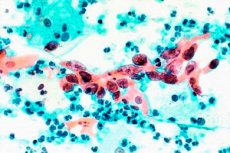
Liquid cytology of the cervix is an innovative method of cytological research, the "gold standard" for diagnosing neoplasia of the canal mucosa and the vaginal part of the uterine neck, which is used when the patient is suspected of having cancer or dysplasia. Thanks to this method of diagnosis, cancer can be detected at the earliest stages of development, which increases the chances of a complete cure.
After taking the smear for oncocytology, the biological material is placed in a certain liquid medium. With the help of a special centrifuge, "washing" of cells (cyto-preparations) takes place, which concentrate in one place and form an even layer. In this case, the conclusion of the cytologist will be more accurate and informative than in the usual cytology, when the material taken for the study is immediately applied to the medical glass for analysis.
Today, in medicine, the PAP test technology (ThinPrep) is increasingly being used. The advantage of this innovation is the high definition of the image of the cells. Using this technology, the resulting material is mixed with a special solution that mechanically separates the epithelial cells from contamination. As a result of such a study, the number of false-negative answers is much reduced.
Indications
Liquid cytology of the cervix as a gynecological method of research helps in choosing the most effective ways to treat cancer. With the help of this method, it is possible to determine the presence of malignant cells, as well as the degree of development of the disease. Cervical screening should be done with the onset of sexual activity. The risk group includes women with the papilloma virus.
Indication for the study:
- pregnancy planning;
- violation or from bouts of the menstrual cycle (too short or long cycle, frequent delays);
- infertility;
- presence of several sexual partners;
- gynecological pathologies of viral etiology ( genital warts, genital herpes, etc.);
- long-term use of contraceptive and hormonal drugs;
- causeless appearance of vaginal discharge;
- preparation for the installation of contraceptives (intrauterine spiral, etc.).
Cervical screening is aimed at the diagnosis of papillomavirus infection and cervical lesions and the adoption of therapeutic and preventive measures. It is recommended to take a smear in the first week after the end of menstruation. The result can be "normal" (negative), indicating the absence of pathologies in the cervix, and "pathological" (positive) - if the sample identified atypical cells, which can subsequently lead to the development of cancer.
Advantages of liquid cytology
Liquid cytology of the cervix allows you to obtain the most accurate result of the study of cells for the presence or absence of pathologies.
Advantages of liquid cytology are in the improved quality of the obtained biomaterial. In addition, it should be noted:
- rapid preparation of the preparation;
- long shelf life and storage of material (with PreservCyt stabilizing solution it is possible to prevent cell drying, this allows to save the sample under the most favorable conditions for its subsequent transportation to the medical laboratory);
- the possibility of preparing several cytological preparations from the obtained biomaterial;
- application of standardized staining techniques;
- possibility of monolayer smear preparation.
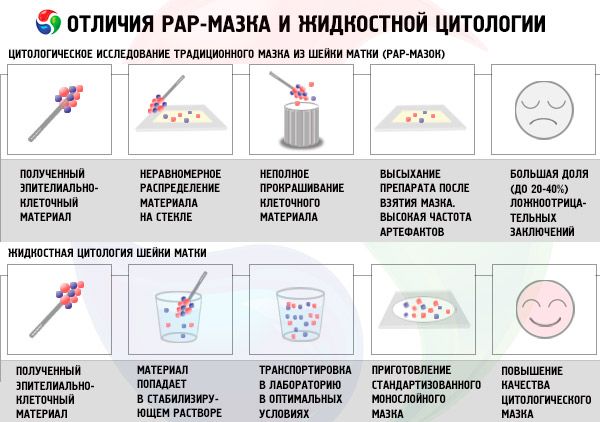
The use of liquid cytology - a new technology for cancer screening, in comparison with the traditional method, significantly improves the quality of the cytological smear, and also provides the opportunity to use additional diagnostic methods without a secondary gynecological examination.
The screening method is recommended to be applied with certain regularity for the timely prevention of cervical cancer. It allows to reveal the initial stages of cancer, as well as precancerous and background processes of the cervical epithelium.
Preparation
Fluid cytology of the cervix is a quick and accessible method of gynecological examination, with the help of which it is possible to obtain accurate information about any deviations in cervical cells. The fence is removed during the examination of the patient in the gynecological chair.
Preparation for this procedure includes abstention from:
- sexual relations for 2 days before taking the smear;
- douching (sanitation) of the vagina;
- the use of vaginal suppositories and spermicidal ointments;
- reception of contraceptive and anti-inflammatory drugs (tablets);
- the introduction of tampons into the vagina.
It should be emphasized that the analysis for liquid cytology is one of the most informative. The removal of the smear is quick and painless - this method of examination is widely used in gynecology. 2-3 hours before the PAP test, you need to refrain from urinating. You can not do the analysis on menstruation days, with vaginal discharge, itching, the presence of an inflammatory process.
The procedure is very simple: a gynecologist cleans the cervix with a cotton swab, and then uses a special brush to take the material for analysis and apply it to the medical glass. After this, a laboratory study of the contents is carried out under a microscope. The results of the analysis will be available in about 7-10 days. Cytological smear allows you to determine the shape, size, ordering of cells, which helps diagnose cervical diseases, including cancer and precancerous conditions. This examination is recommended to be conducted at least once a year.
Equipment for liquid cytology
Liquid cytology of the cervix is an innovative method of examination, which allows for accurate diagnosis of a vaginal smear for the purpose of detecting cancer. The PAP test was introduced into medicine by the Greek scientist George Papanikolaou and in a short period of time helped to significantly reduce the death rate of patients diagnosed with "cervical cancer", as well as other pathologies (endometrium, etc.). Using this method, it is possible to obtain a prediction with a higher degree of probability than with simple cytological analysis.
In the process of taking a smear for oncocytology, the gynecologist uses a special form of cytobrush, which, together with the biomaterial, is placed in a special stabilizing solution. Cells, thus, can be fully preserved, which guarantees a more qualitative, accurate and reliable result.
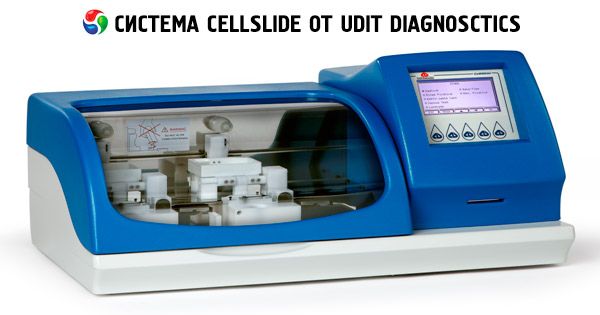
The equipment for liquid cytology is an automatic processor that performs operations on manufacturing a cytopreparation using a clearly defined program. Increase the quality of the study contributes to a uniform distribution of the cytopean on a special slide-glass.
For the analysis, a certain amount of biomaterial is used, after which the cells pass through the vacuum filter, cleansing of such impurities as mucus and blood. For further microscopy, a homogeneous cell layer is placed on the slide. Placed on the glass slide, the purified preparation provides a higher accuracy of both the research process itself and the result obtained.
It should be emphasized that when using the method of liquid cytology, the sensitivity of the test reaches 95%, while in the traditional cytological analysis - only 40-60%. On the recommendation of WHO, liquid cytology is the "gold standard" of smear testing. A high accuracy of the result is achieved by using a combination of a cytoplate, stabilizing solution and filtration. This allows timely diagnosis of cervical cancer and take the necessary measures for effective treatment.
 [17]
[17]
Techniques for conducting
Fluid cytology of the cervix is based on a laboratory study of the selected biomaterial. Since cervical cancer develops over a long period of time (several years), a regular check-up will help to identify pathology in the early stages of oncological disease. Thus, treatment will be more effective.
The technique of liquid cytology is quite simple: the examination is carried out using a gynecological chair. Before the procedure begins, a gynecological mirror is inserted into the vagina to visually inspect its canal and cervix. Then, the neck is cleared of discharge with a cotton swab. With the help of a sterile cervical brush (endobrush), the gynecologist performs a biomaterial sampling (scraping). The sample is placed in a special solution, which prevents the cells from drying out, and then spreads over the glass. Such a solution cleanses biomaterials from contaminants (mucus and leukocytes) and preserves the integrity of the epithelial cells. The procedure is absolutely painless and takes a little time. The results of the analysis will be ready in about a week.
Reliable results can be obtained only with a clear observance of the technique of taking a smear. The analysis should be performed no earlier than the fifth day after the beginning of the menstrual cycle and no later than the 5th day before the expected onset of menstruation. The result will be unreliable if any medical preparations (candles, contraceptives) were taken before taking material in the vagina, vaginal sanitation was performed, and sexual intercourse occurred 24 hours before the liquid cytology.
Liquid PAP cytology
Fluid cytology of the cervix is the most informative method of gynecological examination for the presence of atypical (cancerous) cells. To date, this is a regular test, which is carried out with the usual gynecological examination of women.
Liquid Papil cytology (Pap test) is the study of smears (cell samples) taken from the neck surface. This method was discovered in the 1920s. The last century George Papanikolaou - a Greek scientist and physician who, carrying out studies in rats and doing smears with the Central Committee, detected infections and tumors. Thus, the scientist came up with the idea to use this method of cytological diagnosis when examining women. Officially it was used in 1943.
The test is aimed at the timely detection and diagnosis of cervical cancer. It is based on the application of the method of staining the samples taken in a manner similar to microscopic examination. Using coloring, it is possible to determine the response of cellular structures to basic and acidic dyes. Today it is practiced all over the world as one of the main ways of research of oncological diseases.
The swab is smeared using the Eyre spatula (a special brush). Samples are transferred to the glass, and then processed with a fixing solution and sent to a medical laboratory for thorough research using color. This helps to determine reactive, inflammatory, benign or malignant processes. In most cases with the help of the Pap test it is possible to identify the slightest pathology of the cervix at the cellular level even before the oncological disease develops, which makes it possible to assign effective treatment in time.
Smear for liquid cytology
Fluid cytology of the cervix is a simple and accurate analysis with which you can assess the condition of tissues and identify possible pathologies. The procedure is completely safe and relatively painless. The main goal of this study is to identify atypical cells that can eventually degenerate into a cancerous tumor. Timely diagnosis of adverse changes and pathologies at the earliest stages will make treatment more rapid and effective.
A smear for liquid cytology helps to determine the general condition of the mucosa and reveal pathology. To date, this method of gynecological examination is considered the most accessible and reliable. With the help of a smear it is possible to determine the composition of the microflora of the vagina, as well as the degree of its purity. To obtain the most accurate result about the condition of the cervix, the gynecologist can perform a number of additional tests (colposcopy, biopsy).
This study helps to identify viral infections and other factors that can trigger tumor development. The smear is taken with a special brush from three different zones of the vaginal mucosa: from the cervical canal, its surface and arches. Samples are immersed in a vial with a solution that prevents the cells from drying out and their bacterial "clogging", and then are applied to a special glass and sent to a medical laboratory for thorough examination. To this end, a method of staining by Pap test is used.
The solution used in the cytological study is resistant to sharp temperature fluctuations, and also guarantees long-term storage of cellular material, which makes it possible to conduct additional tests for the full spectrum of genital infections, including genetic testing for HPV. Thus, for the conduct of all studies, you can use the same vial with a liquid cytological material. At the same time, additional visits to the doctor from the patient will not be required.
Explanation of results
Liquid cytology of the cervix is the simplest and most reliable method of gynecological examination, which allows to reveal various pathologies, including cancer in the early stages of development.
The interpretation of the results of this cytological study is aimed at evaluating the state of the epithelial cells. A total of 5 states (stages of development, classes) of the disease:
- 1 - there are no pathological disorders in the cell structure, the norm;
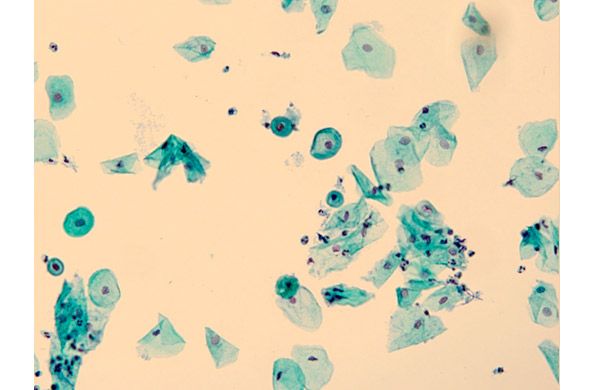
- 2 - there is a decrease in the morphological norm of some cell elements; suspected inflammation or an infectious disease (eg, vaginosis); for more accurate diagnosis and treatment, additional examination methods will be needed - colposcopy and / or biopsy;
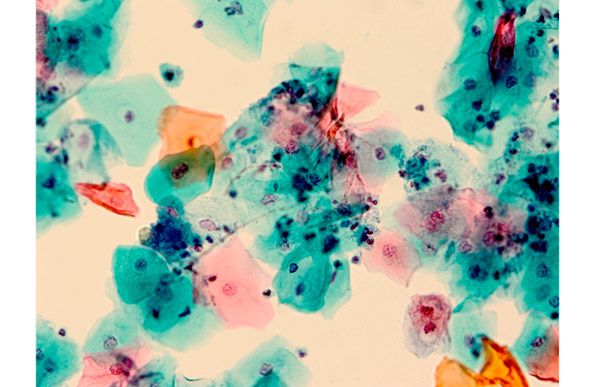
- 3 - abnormal changes are observed in single cells; a re-examination is necessary;
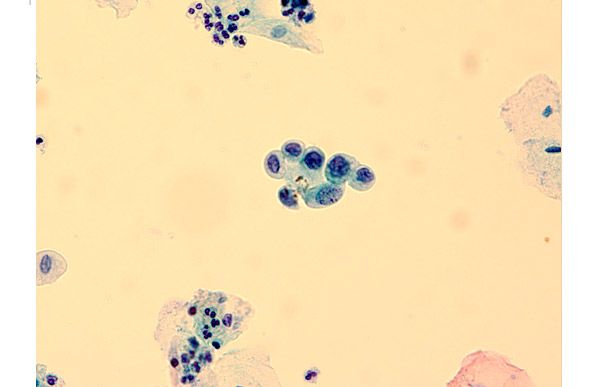
- 4 - malignant changes in the structure of cells that indicate a precancerous condition;
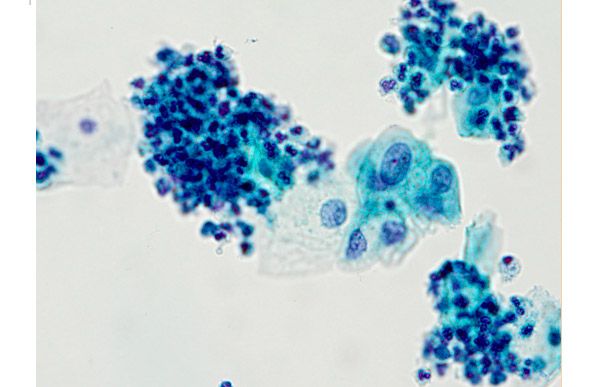
- 5 - a large number of atypical cells was found, which indicates the initial degree of development of a cancerous tumor.

To obtain the most accurate results, the analysis of the analyzes takes place according to the Bethesda system. The final diagnosis is established based on the information received about the changes in the cell nucleus and the location of the cells. CBO - an abbreviation, indicating the norm of all indicators.
The following abbreviations are used in deciphering the results of the analysis to denote various pathological changes:
- ASC-US - changes in flat epithelial cells are observed; often such an index occurs in women aged 45 years due to a decrease in the level of estrogen;
- AGC - altered cylindrical cells, which is an indicator of inflammatory diseases (for example, vaginosis);
- LSIL - there is a small percentage of atypical cells with non-cancerous etiology;
- ASC-H - abnormalities in the cellular structure, indicating a precancerous condition (dysplasia) or the initial stage of cancer development;
- HSIL - this abbreviation indicates oncocytology, which is confirmed by the presence in the sample of altered planar cells;
- AIS is the presence of a cylindrical epithelium in the cell smear, which indicates cancer.
Complications
Fluid cytology of the cervix is a painless and simple procedure. At the same time, it gives the most informative result about the presence or absence of any pathologies. This is an effective method for diagnosing cervical cancer in the first stages of the disease. The swab of the smear for oncocytology should be performed by a specialist doctor who knows the technique of this process.
Complications after the survey usually do not arise. In some cases, there may be only small bleeding from the vagina, which occurs after 2-3 days and does not require special treatment. After manipulation, severe soreness may also occur. Such symptoms are considered normal, but if other signs (fever, chills, severe pain) have joined them, you should consult your doctor.
If the fence is not properly seated, dangerous consequences can occur. So, gross intervention provokes the development of stenosis as a result of the formation of adhesions. Therefore, it is not accepted to take a smear for cytology in the deep zones of the cervical canal. In order to avoid any complications, a woman is recommended to abandon sexual relations, use of tampons and vaginal douching within 7-10 days after the PAP test.
Discharge after liquid cytology
Fluid cytology of the cervix is an effective method used in gynecology to identify pathologies associated with inflammatory or infectious diseases, as well as the development of cancer. Usually the procedure is painless and does not cause any inconvenience to the woman.
Allocations after fluid cytology can be observed about 5-7 days after the study. Most often they have a dark brown or dirty green color. This is normal, so no special treatment is required. During this period it is recommended to use usual sanitary napkins.
If a woman complains of copious spotting and severe soreness after taking a smear - most likely, the technique of taking cytological material was broken. In this case, you need to see a doctor to prevent possible complications, from which you can note the stenosis of the canal, provoked by spikes. This complication is possible with a rough intervention in the cervical canal zone.
Within a few days after this study, it is necessary to observe the condition. If spotting is accompanied by fever, chills, abdominal pain, seek medical help as soon as possible.
Fluid cytology of the cervix is a "gold standard" of studies aimed at timely diagnosis of cancer. With the help of this gynecological method, it is possible to detect precancerous conditions, as well as malignant changes in the early stages. In addition to cellular abnormalities, a cervical smear makes it possible to "determine" the presence of pathogenic microorganisms, sexual infections, viruses and assess the condition of the mucosa. Every woman needs to remember the importance and necessity of a regular (annual) examination.

